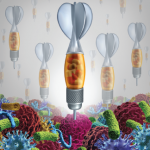Following an internal medical residency, which included an 18-month rotation in rheumatology, Dr. Smolen applied for a post-doctoral fellowship in the United States. One of the people with whom Professor Smolen interviewed was Dr. Lipsky, then at the University of Texas Southwestern Medical Center at Dallas.
“During that interview,” recalls Dr. Lipsky, “he asked me very earnestly where I would recommend that he go. Of course, he was looking at a position in Dallas, when I recommended that he go to the NIH!” And, in fact, Dr. Smolen did do a fellowship at the Arthritis and Rheumatism Branch at the NIH, first under Director J.L. Decker, MD, and then in the section for cellular immunology under Chief A.D. Steinberg, MD. Then it was back to Vienna, where he was offered a professorship in rheumatology. “That had been a long-standing professorship,” remarks Dr. Lipsky, “but since Josef has taken it over, he has really developed it into one of the most influential of professorships in Europe.”
From DAREA to SDAI
The CDAI had its beginnings in Dr. Smolen’s activities with international rheumatology organizations. From 1991 to 1997, he served as chair of the European League Against Rheumatism (EULAR) Standing Committee for International Clinical Studies Including Therapeutic Trials (ESCISIT). Discussions in committee meetings during the early to mid 90s identified the need to improve outcomes measures in rheumatology. The Disease Activity Score (DAS) and DAS-28, a continuous scale developed at the University of Nijmegen in the Netherlands by Piet van Riel, MD, PhD, and Desiree van der Heijde, MD, PhD, rose to prominence as therapeutic trials increased. (See “To Measure is to Know,” in the October issue, p. 24, for more on Dr. van Reil and the DAS.)
“I was personally very happy that these new criteria were developed, be it the ACR criteria, the EULAR response criteria, or the DAS-28,” Dr. Smolen notes, and that “they performed well in clinical trials and were something new and helpful. However, all these calculations of response were relatively tedious.” (ACR criteria require calculation of percentages of improvement, and the DAS requires performing square roots and factoring.)
He and his teams at the Hietzing Hospital and the Medical University in Vienna first embarked upon the quest for a simplified disease activity index to meet a need in reactive arthritis, for which there was no existing disease activity score. Because reactive arthritis is usually oligoarticular, they reasoned, they could use the variables most sensitive to change (joint counts, patient and evaluator global assessments, and C-reactive protein [CRP]) and come up with a simple numerical summation of values to assess disease activity. With the help of Gabriele Eberl, MD, of the second department of medicine at Lainz Hospital in Vienna, the Disease Activity index for Reactive Arthritis (DAREA) was developed and validated.1

